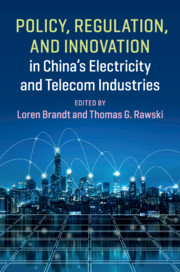Book contents
- Policy, Regulation, and Innovation in China’s Electricity and Telecom Industries
- Policy, Regulation, and Innovation in China’s Electricity and Telecom Industries
- Copyright page
- Contents
- Figures
- Tables
- Contributors
- Acknowledgments
- Abbreviations
- Map of China
- 1 Policy, Regulation, and Innovation in China’s Electricity and Telecom Industries
- 2 China’s Electricity and Communications Regulation in Global Context
- 3 Local Government and Firm Innovation in China’s Clean Energy Sector
- 4 Technology Integration in China’s Electricity System: Central Targets and Local Challenges
- 5 When Global Technology Meets Local Standards
- 6 The Search for High Power in China: State Grid Corporation of China
- 7 Growth, Upgrading, and Limited Catch-Up in China’s Semiconductor Industry
- 8 Growth, Upgrading, and Excess Cost in China’s Electric Power Sector
- 9 China’s Development of Wind and Solar Power
- 10 Capability Upgrading and Catch-Up in Civil Nuclear Power: The Case of China
- Index
- References
7 - Growth, Upgrading, and Limited Catch-Up in China’s Semiconductor Industry
Published online by Cambridge University Press: 08 June 2019
- Policy, Regulation, and Innovation in China’s Electricity and Telecom Industries
- Policy, Regulation, and Innovation in China’s Electricity and Telecom Industries
- Copyright page
- Contents
- Figures
- Tables
- Contributors
- Acknowledgments
- Abbreviations
- Map of China
- 1 Policy, Regulation, and Innovation in China’s Electricity and Telecom Industries
- 2 China’s Electricity and Communications Regulation in Global Context
- 3 Local Government and Firm Innovation in China’s Clean Energy Sector
- 4 Technology Integration in China’s Electricity System: Central Targets and Local Challenges
- 5 When Global Technology Meets Local Standards
- 6 The Search for High Power in China: State Grid Corporation of China
- 7 Growth, Upgrading, and Limited Catch-Up in China’s Semiconductor Industry
- 8 Growth, Upgrading, and Excess Cost in China’s Electric Power Sector
- 9 China’s Development of Wind and Solar Power
- 10 Capability Upgrading and Catch-Up in Civil Nuclear Power: The Case of China
- Index
- References
Summary
Semiconductors represent a major building block of high-tech industry. This chapter analyzes the trajectory of China’s rapidly growing semiconductor sector, focusing on the interplay among global technology developments, Chinese government policy, and three groups of firms: purely domestic manufacturers, Chinese operations of multi-national corporations, and hybrid firms based in China but with offshore ownership and financing.
China has pursued policies aiming to build a globally competitive domestic industry. Policy instruments include outlays on technical education, and more focused initiatives that channel investment funds, imported technology and product demand toward domestic firms, mostly state-owned ones. Despite strong government backing, domestic state-owned firms have generally failed to generate technological dynamism. Only the hybrids have delivered substantial technological advance.
Recent policy initiatives continue to lavish resources on state-owned firms while limiting the capacity of potentially more innovative hybrid and domestic private operators to expand and upgrade. As a result, China’s semiconductor industry appears locked into a path that combines quantitative expansion with low financial returns and limited qualitative improvement. This trajectory offers little prospect for attaining China’s long-term objective of propelling domestic semiconductor manufacture toward the global frontier of technology and innovation.
Keywords
- Type
- Chapter
- Information
- Publisher: Cambridge University PressPrint publication year: 2019
References
References
- JJGC
经济观察 Economic Observer
- EE Times
Electrical Engineering Times
- ESJJBD
二十一世纪经济报道 The 21st Century Economic Herald
- FT
Financial Times
- NYT
New York Times
- SCMP
South China Morning Post
- WSJ
Wall Street Journal
经济观察 Economic Observer
Electrical Engineering Times
二十一世纪经济报道 The 21st Century Economic Herald
Financial Times
New York Times
South China Morning Post
Wall Street Journal
Newspaper Abbreviations
- JJGC
经济观察 Economic Observer
- EE Times
Electrical Engineering Times
- ESJJBD
二十一世纪经济报道 The 21st Century Economic Herald
- FT
Financial Times
- NYT
New York Times
- SCMP
South China Morning Post
- WSJ
Wall Street Journal
经济观察 Economic Observer
Electrical Engineering Times
二十一世纪经济报道 The 21st Century Economic Herald
Financial Times
New York Times
South China Morning Post
Wall Street Journal
- 8
- Cited by



